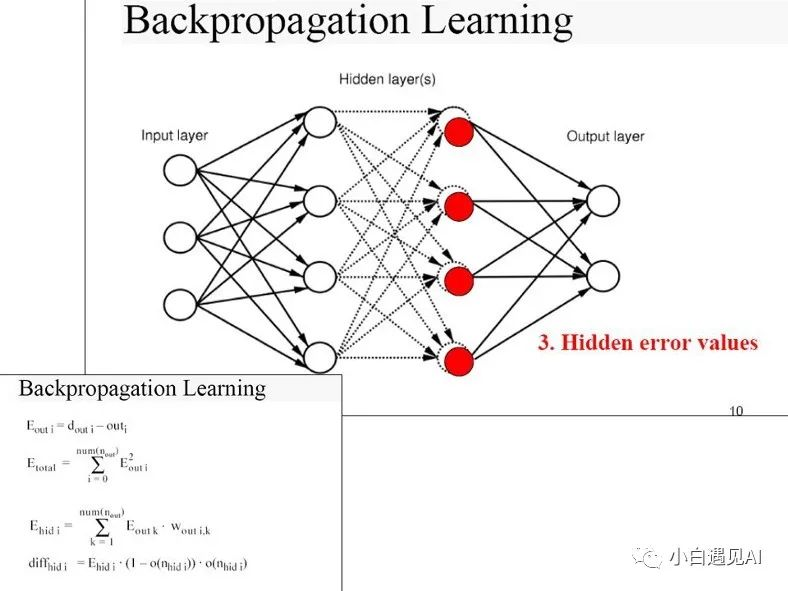在神經網絡中實現反向傳播
建立神經網絡時,需要采取幾個步驟。其中兩個最重要的步驟是實現正向和反向傳播。這兩個詞聽起來真的很沉重,并且總是讓初學者感到恐懼。但實際上,如果將這些技術分解為各自的步驟,則可以正確理解它們。在本文中,我們將專注于反向傳播及其每個步驟的直觀知識。
什么是反向傳播?
這只是實現神經網絡的一項簡單技術,允許我們計算參數的梯度,以執行梯度下降并使成本函數最小化。許多學者將反向傳播描述為神經網絡中數學上最密集的部分。不過請放輕松,因為在本文中我們將完全解密反向傳播的每個部分。

實施反向傳播
假設一個簡單的兩層神經網絡-一個隱藏層和一個輸出層。我們可以如下執行反向傳播初始化要用于神經網絡的權重和偏差:這涉及隨機初始化神經網絡的權重和偏差。這些參數的梯度將從反向傳播中獲得,并用于更新梯度下降。
#Import Numpy library
import numpy as np
#set seed for reproducability
np.random.seed(100)
#We will first initialize the weights and bias needed and store them in a dictionary called W_B
def initialize(num_f, num_h, num_out):
'''
Description: This function randomly initializes the weights and biases of each layer of the neural network
Input Arguments:
num_f - number of training features
num_h -the number of nodes in the hidden layers
num_out - the number of nodes in the output
Output:
W_B - A dictionary of the initialized parameters.
'''
#randomly initialize weights and biases, and proceed to store in a dictionary
W_B = {
'W1': np.random.randn(num_h, num_f),
'b1': np.zeros((num_h, 1)),
'W2': np.random.randn(num_out, num_h),
'b2': np.zeros((num_out, 1))
}
return W_B執行前向傳播:這涉及到計算隱藏層和輸出層的線性和激活輸出。
對于隱藏層:我們將使用如下所示的relu激活功能:
#We will now proceed to create functions for each of our activation functions
def relu (Z):
'''
Description: This function performs the relu activation function on a given number or matrix.
Input Arguments:
Z - matrix or integer
Output:
relu_Z - matrix or integer with relu performed on it
'''
relu_Z = np.maximum(Z,0)
return relu_Z對于輸出層:
我們將使用S型激活函數,如下所示:
def sigmoid (Z):
'''
Description: This function performs the sigmoid activation function on a given number or matrix.
Input Arguments:
Z - matrix or integer
Output:
sigmoid_Z - matrix or integer with sigmoid performed on it
'''
sigmoid_Z = 1 / (1 + (np.exp(-Z)))
return sigmoid_Z執行前向傳播:
#We will now proceed to perform forward propagation
def forward_propagation(X, W_B):
'''
Description: This function performs the forward propagation in a vectorized form
Input Arguments:
X - input training examples
W_B - initialized weights and biases
Output:
forward_results - A dictionary containing the linear and activation outputs
'''
#Calculate the linear Z for the hidden layer
Z1 = np.dot(X, W_B['W1'].T) + W_B['b1']
#Calculate the activation ouput for the hidden layer
A = relu(Z1)
#Calculate the linear Z for the output layer
Z2 = np.dot(A, W_B['W2'].T) + W_B['b2']
#Calculate the activation ouput for the ouptu layer
Y_pred = sigmoid(Z2)
#Save all ina dictionary
forward_results = {"Z1": Z1,
"A": A,
"Z2": Z2,
"Y_pred": Y_pred}
return forward_results執行向后傳播:相對于與梯度下降相關的參數,計算成本的梯度。在這種情況下,為dLdZ2,dLdW2,dLdb2,dLdZ1,dLdW1和dLdb1。這些參數將與學習率結合起來執行梯度下降。我們將為許多訓練樣本(no_examples)實現反向傳播的矢量化版本。
分步指南如下:
- 從傳遞中獲取結果,如下所示:
forward_results = forward_propagation(X, W_B)
Z1 = forward_results['Z1']
A = forward_results['A']
Z2 = forward_results['Z2']
Y_pred = forward_results['Y_pred']- 獲得訓練樣本的數量,如下所示:
no_examples = X.shape[1]- 計算函數的損失:
L = (1/no_examples) * np.sum(-Y_true * np.log(Y_pred) - (1 - Y_true) * np.log(1 - Y_pred))- 計算每個參數的梯度,如下所示:
dLdZ2= Y_pred - Y_true
dLdW2 = (1/no_examples) * np.dot(dLdZ2, A.T)
dLdb2 = (1/no_examples) * np.sum(dLdZ2, axis=1, keepdims=True)
dLdZ1 = np.multiply(np.dot(W_B['W2'].T, dLdZ2), (1 - np.power(A, 2)))
dLdW1 = (1/no_examples) * np.dot(dLdZ1, X.T)
dLdb1 = (1/no_examples) * np.sum(dLdZ1, axis=1, keepdims=True)- 將梯度下降所需的計算梯度存儲在字典中:
gradients = {"dLdW1": dLdW1,
"dLdb1": dLdb1,
"dLdW2": dLdW2,
"dLdb2": dLdb2}- 返回損耗和存儲的梯度:
return gradients, L這是完整的向后傳播功能:
def backward_propagation(X, W_B, Y_true):
'''Description: This function performs the backward propagation in a vectorized form
Input Arguments:
X - input training examples
W_B - initialized weights and biases
Y_True - the true target values of the training examples
Output:
gradients - the calculated gradients of each parameter
L - the loss function
'''
# Obtain the forward results from the forward propagation
forward_results = forward_propagation(X, W_B)
Z1 = forward_results['Z1']
A = forward_results['A']
Z2 = forward_results['Z2']
Y_pred = forward_results['Y_pred']
#Obtain the number of training samples
no_examples = X.shape[1]
# Calculate loss
L = (1/no_examples) * np.sum(-Y_true * np.log(Y_pred) - (1 - Y_true) * np.log(1 - Y_pred))
#Calculate the gradients of each parameter needed for gradient descent
dLdZ2= Y_pred - Y_true
dLdW2 = (1/no_examples) * np.dot(dLdZ2, A.T)
dLdb2 = (1/no_examples) * np.sum(dLdZ2, axis=1, keepdims=True)
dLdZ1 = np.multiply(np.dot(W_B['W2'].T, dLdZ2), (1 - np.power(A, 2)))
dLdW1 = (1/no_examples) * np.dot(dLdZ1, X.T)
dLdb1 = (1/no_examples) * np.sum(dLdZ1, axis=1, keepdims=True)
#Store gradients for gradient descent in a dictionary
gradients = {"dLdW1": dLdW1,
"dLdb1": dLdb1,
"dLdW2": dLdW2,
"dLdb2": dLdb2}
return gradients, L許多人總是認為反向傳播很困難,但是正如本文中介紹的情形,事實并非如此。必須掌握每個步驟,才能掌握整個反向傳播技術。另外,有必要掌握線性代數和微積分等數學知識,以了解如何計算每個函數的各個梯度。使用這些工具,反向傳播應該是小菜一碟!實際上,反向傳播通常由使用的深度學習框架來處理。但是,了解這種技術的內在作用是值得的,因為它有時可以幫助我們理解神經網絡為何訓練得不好。
本文轉載 ??小白遇見AI?? ,作者:小煩

















